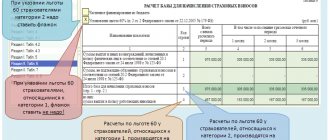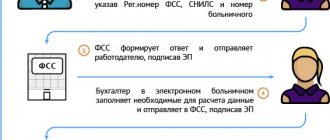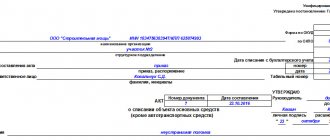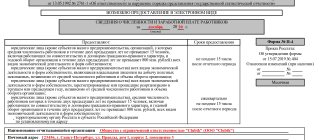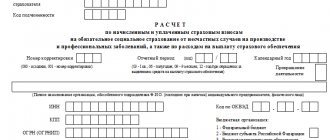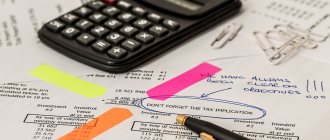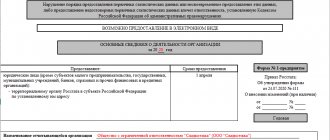Mandatory reporting forms
In addition to these documents, the annual financial report includes several more appendices and independent reporting forms. Suffice it to say that there are as many as eight appendices to the above order, and this is only for those organizations that are not state, credit, financial or pension funds, since they have their own specific reports. The complete list of financial forms that business companies must fill out is as follows:
- accounting (financial) reporting form (KND 0710099);
- balance sheet (OKUD 0710001) No. 1;
- financial results report (OKUD 0710002) No. 2;
- statement of changes in capital (OKUD 0710003) No. 3;
- cash flow statement (OKUD 0710004) No. 4;
- report on the intended use of funds (OKUD 0710006) No. 5;
- explanations to the balance sheet and income statement;
- simplified accounting (financial) statements (KND 0710096, balance sheet - OKUD 0710001, financial performance report - OKUD 0710002, report on the intended use of funds - OKUD 0710006);
Application of the order on the forms of financial statements of organizations
Carrying out any business activity, even a non-commercial one, requires the provision of financial statements. Accounting statements allow you to formulate the final performance indicators of an enterprise for a certain period.
The information reflected in the financial statements allows you to analyze the situation, make competent management decisions, and control the amount of accrued and paid taxes.
According to Order No. 66n, separate forms of financial statements have been approved, which can be found in the corresponding appendix.
Please note that the regulations of this order do not apply to credit organizations and state municipal institutions.
This order has four appendices, each of which has several reporting forms:
- Appendix number 1 - consists of a balance sheet and profit and loss account;
- Appendix number 2 - consists of three reporting forms: a report on changes in capital, a report on the intended use of funds received, and a report on their movement;
- Appendix 3 contains examples of the formatting of explanations that are prepared for the profit and loss statement and balance sheet.
Thus, when drawing up an explanatory note, it is necessary to adhere to clear regulations for its execution:
- the presence of a tabular or text form;
- the explanatory tabular form is drawn up taking into account the requirements of Appendix No. 3 of this order;
- Appendix No. 4 indicates the encoding of the lines, which is indicated in the financial reporting forms. Provided at the end of the year to state statistics bodies and other executive authorities.
We remind you that according to paragraph 5 of Order No. 66n, after the “Name” column, it is necessary to indicate the code of the indicator approved in Appendix No. 4 of this Order.
Appendix No. 5 consists of simplified forms of financial statements:
- balance sheet;
- financial results report;
- a report on the intended use of the funds received;
Please note that according to paragraph 3 of Order No. 66n, the organization has the right to independently determine the detail of indicators for the articles of the reports that were listed above.
For small businesses that provide simplified financial statements, the right is provided to show the line code for the aggregated indicator, which has the largest share among all indicators of the organization. That is, there is no need to detail indicators by item.
The reporting itself is generated according to a simplified scheme - only the most essential information is filled in, without which it is simply impossible to assess the real financial position of the organization and the results of its activities.
Consequently, when preparing financial statements, including according to a simplified scheme, the requirements of paragraphs 1 – 4 of Order No. 66n are applied.
Accounting statements -2020: how, where and when to submit
Accounting reporting forms 2021 must be submitted to the territorial body of Rosstat at the location of the organization and its branches, if they maintain separate accounting and have the appropriate status, as well as to the Federal Tax Service inspection at the place of registration of the taxpayer.
The set of documents for these two bodies is the same. Those organizations that are required by law to undergo an annual audit must submit an audit report along with their balance sheet. Although, by law, they have until December 31, 2021 to do this, it is better not to delay. After all, Article 18 of the Federal Law of December 6, 2011 No. 402-FZ defines the obligation of a legal entity to send audit documents to Rosstat within 10 working days from the day following the end date.
Sample cash flow statement
Filling out Form 4 begins with the so-called “header” of the form.
First, fill out a line with the organization’s data: name, identification code, indicate the type of activity (must correspond to the constituent documents).
Then comes the division of cash flows into three categories: current operations, investment operations and financial operations. Each of these categories is divided into two subcategories: receipts and payments.
Before each type of transaction there are two columns in which it is necessary to reflect the amount of money passed through these transactions: column 3 for the reporting year, column 4 for the previous reporting year. When filling out Form 4 for 2014, you need to reflect information for 2014 and 2013.
Filling out the section “Cash flows for current operations”
Income:
4110 – the total amount of receipts is indicated.
4111-4119 – their decoding:
- sale of goods, works and services
- payment of funds for rent, licenses, royalties
- assignment of rights to claim monetary payments
- other supply.
Payments are based on a mirror basis:
4120 – total amount of payments.
4120-4129 – transcript:
- funds spent on the purchase of goods, works and services
- salary fund
- interest on loan obligations
- funds spent on paying taxes and other obligatory payments.
- other payments.
It is interesting that current operations include all operations that cannot be confidently attributed to other sections.
Line 4100 of Form 4 indicates the balance of cash flows.
Completion of this section of Form 4 can be seen in the completed sample report, which can be downloaded from the link below.
Completing the section “Cash flows from investment operations”
Investment operations represent investments in scientific developments, the purchase of shares from other enterprises, expenses for payments under contract agreements, and employees in connection with the investment operations of the enterprise.
Income:
4210 – total amount of receipts.
4211-4219 – transcript:
- The sale of non-current assets (intangible assets, real estate, fixed assets of production) does not include financial investments in these assets.
- From transactions for the alienation of shares of other enterprises
- From the sale of debt securities, return of previously issued loans
- From income in the form of investments in enterprises, shares, deposits
- Other supply.
Payments:
4220 – total amount of payments.
4221-4229 – transcript:
- Expenses for updating, repairing equipment, scientific developments, incl. and non-current assets
- Purchase of shares of other enterprises, shares
- Purchase of debt securities, rights of claim, spending on loans
- Interest on obligations arising from investment transactions
- other payments.
Line 4200 of the cash flow statement indicates the balance of cash flows from investment operations.
For the completed second section of Form 4, see the completed sample report, which can be downloaded from the link below.
Completing the section “Cash flows from financial transactions”
Financial transactions are associated with attracting additional capital in the form of loans, borrowings or the sale of shares in equity capital.
Income:
4310 – total amount of receipts.
4311-4319 – their decoding:
- Receiving credit funds
- Increase in participant contributions
- Issue of shares
- Issue of debt securities (bonds).
Payments:
4320 – total amount of payments.
4321-4329 – their decoding:
- Owners upon purchase of their shares, shares in case of exit
- Payment of part of the profit
- Payment of debt securities, obligations (credits, borrowings).
When filling out data for each category of Form 4, you need to note the balance: the difference between payments and receipts.
Form 4 of reporting must reflect the amount of cash balance at the beginning and end of the reporting period.
4400 – cash flow balance – the sum of lines 4100, 4200, 4300. If the result is a negative number, reflect it in parentheses.
4450 – balance at the beginning of the reporting period – the amount of cash balance at the beginning of the year.
4500 – balance at the end of the reporting period – the amount of cash balance at the end of the year.
4490 – the impact of changes in exchange rates against the ruble – reflects the total amount of exchange rate differences that arose in connection with the conversion of currency into rubles.
It is important to know that the cash flow statement form does not reflect a complete list of categories of transactions; one transaction may belong to several categories. For example, a single payment may refer to different flows. In this case, the amounts are distributed among the threads. Cash flows are shown in a collapsed form: this means that VAT should not be taken into account in the figures.
When receiving money in foreign currency, a conversion is made into rubles at the rate in effect at the time of the transaction.
It is also now mandatory to record cash equivalents (values that are not constant in price) and that can be sold quickly and without much difficulty.
You can view the completed Form 4 report by downloading a sample form from the link below.
Linking accounting reporting forms for 2021
At this point you need to remember the basic principles and methods of accounting. It is well known that accounting must reliably reflect complete information about the obligations, state of property and capital of the organization and all changes that occur in them. Such control is carried out through a complete, continuous and documentary reflection of all business transactions in the organization on the basis of double entry. This means that each digit in the accounting data is posted to two different accounts, debit and credit. Thanks to this, a balance is achieved when the debit part is always equal to the credit part, if no errors were made. This method naturally concerns accounting results, so all forms of annual financial statements for 2021 are comparable and must be linked to each other. This is, first of all, checked by regulatory authorities when they receive documents from legal entities.
Form No. 3 of the balance sheet
First of all, we note that the title of this material is a deliberate inaccuracy. After all, the balance sheet does not have Form No. 3, and as such, Form No. 3 does not exist in financial statements today. However, users often ask experts specifically about the third form of the balance sheet. Let us explain in order where Form No. 3 of the balance sheet could come from.
The current balance sheet form (form according to OKUD 710001) was approved by Order of the Ministry of Finance of the Russian Federation dated July 2, 2010 No. 66n. The same order approved the form of the balance sheet and profit and loss statement (financial performance report) of small businesses (Appendix No. 5 to Order No. 66n)
Accounting services from RUB 1,667/month
But the forms that were in force until 2011, approved by Order of the Ministry of Finance of Russia dated July 22, 2003 No. 67n (lost force) were numbered. Thus, the balance sheet was considered form No. 1 - this is exactly what was said not only in Order No. 67n , but also indicated on the title page of the report under the line “form according to OKUD”. The profit and loss statement was recognized as Form No. 2.
The new accounting forms do not have numbering: “Form No. 1”, “Form No. 2”, etc. are no longer indicated in the title. For old times’ sake, many accountants still call the balance sheet as Form No. 1, and the profit and loss statement (financial performance statement) as Form No. 2.
Form No. 3 used to be considered a statement of changes in capital. It also exists as part of today's financial statements. You will find the current form (form according to OKUD 0710003) in Appendix No. 2 to Order No. 66n. Small enterprises are not allowed to submit a statement of changes in capital. Therefore, organizations on the simplified tax system and UTII do not necessarily need to study this document. A report will be required only if the organization needs to show and communicate to the inspectorate (founders, owners) important information, without which it is impossible to assess the financial position of the organization.
Accounting reporting using “My Business” You can easily generate accounting and tax reporting using the electronic assistants of the online accounting “My Business”. A step-by-step wizard will guide you through all the lines of the reports - the data will accurately fall into the required columns. And then, with one click, you can send reports to departments via the Internet. Accounting made easy! The “My Business” service will help you!
Add to favorites Press Ctrl+D to add a page to favorites
1 like

